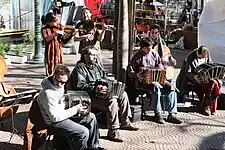
Milonga is a musical genre that originated in the Río de la Plata areas of Argentina, Uruguay, and the Brazilian state of Rio Grande do Sul.[1][2] It is considered a precursor of the tango.
"Milonga is an excited habanera." The original habanera divided into four pulses, in a standard two-four where every note was stressed. In becoming milonga, though, all four notes turned strong, as tempo was doubled. The strength of the first beat weakened the fourth giving an almost waltz-like feel to milonga: one-two-three (four), one-two-three (four). Habanera is a slower, more explicit sounding one, two, three-four. At least one modern tango pianist believes the polka influenced the speeding up of the milonga.[3] According to milonga composer and one of the most famous payadores of his time, Gabino Ezeiza, the milonga derives from various African rhythms such as candombe, and Argentine milonga was particularly popular among Afro-Argentines in Buenos Aires at the turn of the 20th century.[4][5]
Over time, dance steps and other musical influences were added, eventually contributing to the creation of tango.[6]
Notable artists
Artists known for their milonga compositions and interpretations include Roberto Firpo, Angel D'Agostino, Pedro Maffia, Pedro Laurenz, Ángel Villoldo, Francisco Canaro, Rodolfo Biagi, Jorge Drexler, Juan d'Arienzo, Edgardo Donato, Gabino Ezeiza, Aníbal Troilo, Lucio Demare, Domingo Federico, Angel Vargas, Mariano Mores, Alfredo Zitarrosa, Francisco Lomuto, Astor Piazzolla and Carlos Di Sarli. These artists are from the early years and the Golden era of tango. Los Moonlights released a song entitled "Milonga de pelo largo" (Milonga of long hair) on their debut LP, Moonlights.
In Rio Grande do Sul, milonga is an important regional genre and it is part of the repertoire of many gaucho musical groups and interpreters, not to be confused with the Argentinean gauchos. It also continues to influence other genres of the modern gaucho music. José Cláudio Machado's "Milonga Abaixo de Mau Tempo", Renato Borghetti's "Milonga para as Missões" and Jayme Caetano Braun's "Bochincho" are examples of the traditional rio-grandense form of milonga,[2] while Vitor Ramil's "Ramilonga" and Bebeto Alves's "Milonga Orientao" are examples of modern form of this genre.[7]
Argentine composer and pianist Fernando Otero has based many of his orchestral and chamber works on this rhythm, [8] creating compositions for Symphonic Orchestra, String Quartet and Jazz Combos.[9][10][11]
Kevin Johansen is a modern Argentine rock artist who has a number of songs that combine folkloric and pop music with a milonga rhythm.[7]
See also
References
- ↑ Andressa Nathanailidis (2016-03-18). "Milonga: o poema e a música na tradição gaúcha". Terra da Música (in Portuguese).
- 1 2 Mateus Rosa (2019-04-18). "A história da milonga". Repórter Riograndense (in Portuguese).
- ↑ Robert Thompson. "Tango the Art History of Love" page 129
- ↑ Espinosa, Carlos (28 July 2018). "Por el Día del Payador, en memoria del paso de Gabino Ezeiza por Patagones". APP Noticias (in Spanish). Retrieved 1 February 2023.
- ↑ "Gabino Ezeiza, el payador del barrio El Mondongo". Ministerio de Cultura de la Nación (in Spanish). 3 February 2021. Retrieved 1 February 2023.
- ↑ Tango! The Dance, the Song, the Story. Collier, Cooper, Azzi and Martin. 1995. Thames and Hudson, Ltd, p. 51. ISBN 0-500-01671-2.
- 1 2 Guilherme Cruz (January 2013). "Do frio para o mundo: a estética da música platina". Obvious Mag (in Portuguese).
- ↑ Sherrie Rase (March 2013). "Fernando Otero's "Romance" CD". qonstage.com. Archived from the original on 2015-01-04.
- ↑ Frank J. Oteri (2013-03-12). "Sounds Heard: Fernando Otero —Romance". NewMusicBox.
- ↑ Michael Hill. "About Fernando Otero". Nonesuch Records. Retrieved 2013-05-13.
- ↑ Scott Albin (2007-03-11). "Jazz Reviews: Funk Tango Paquito D'Rivera Quintet -By Scott Albin-Jazz Articles". Jazztimes.com. Archived from the original on 2015-01-03. Retrieved 2015-02-25.